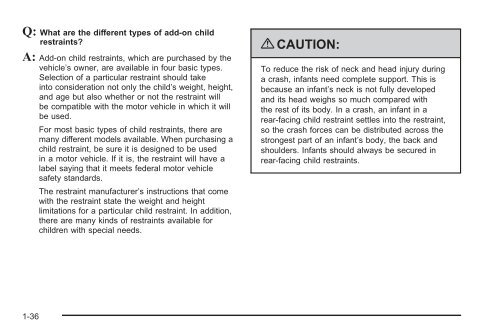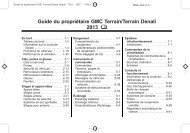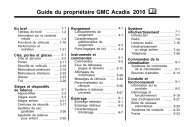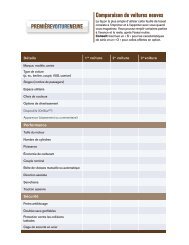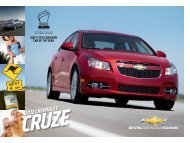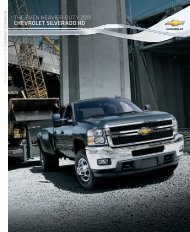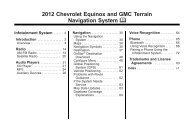- Page 1 and 2: 2009 Chevrolet Express Owner Manual
- Page 3 and 4: Index To quickly locate information
- Page 5 and 6: Section 1 Seats and Restraint Syste
- Page 7 and 8: Power Seat Reclining Seatbacks { CA
- Page 9 and 10: { CAUTION: CAUTION: (Continued) Sit
- Page 11 and 12: 3. Pull the pin handle up to diseng
- Page 13 and 14: Three Passenger Seat Shown 4. Push
- Page 15 and 16: In most states and in all Canadian
- Page 17 and 18: The person keeps going until stoppe
- Page 19 and 20: Q: If my vehicle has airbags, why s
- Page 21 and 22: Q: What is wrong with this? { CAUTI
- Page 23 and 24: Q: What is wrong with this? { CAUTI
- Page 25 and 26: Q: What is wrong with this? { CAUTI
- Page 27 and 28: Q: What is wrong with this? { CAUTI
- Page 29 and 30: 5. To make the lap part tight, pull
- Page 31 and 32: Rear Safety Belt Comfort Guides Rea
- Page 33 and 34: Safety Belt Use During Pregnancy Sa
- Page 35 and 36: The manufacturer’s instructions t
- Page 37 and 38: { CAUTION: Children can be seriousl
- Page 39: { CAUTION: Never do this. Children
- Page 43 and 44: When securing an add-on child restr
- Page 45 and 46: Lower Anchors and Tethers for Child
- Page 47 and 48: Lower Anchor and Top Tether Anchor
- Page 49 and 50: Securing a Child Restraint Designed
- Page 51 and 52: 2.3. Route and tighten the top teth
- Page 53 and 54: 3. Push the latch plate into the bu
- Page 55 and 56: A label on the sun visor says, “N
- Page 57 and 58: 5. Pull the rest of the shoulder be
- Page 59 and 60: CAUTION: (Continued) Secure rear-fa
- Page 61 and 62: 5. Pull the rest of the shoulder be
- Page 63 and 64: Here are the most important things
- Page 65 and 66: If the vehicle has one, the right f
- Page 67 and 68: When Should an Airbag Inflate? Fron
- Page 69 and 70: How Does an Airbag Restrain? In mod
- Page 71 and 72: Airbag Off Switch If the instrument
- Page 73 and 74: { CAUTION: If the airbag readiness
- Page 75 and 76: { CAUTION: CAUTION: (Continued) A c
- Page 77 and 78: { CAUTION: If the airbag readiness
- Page 79 and 80: Additional Factors Affecting System
- Page 81 and 82: In addition, the vehicle may have a
- Page 83 and 84: Replacing Restraint System Parts Af
- Page 85 and 86: Section 2 Features and Controls Key
- Page 87 and 88: Remote Keyless Entry (RKE) System I
- Page 89 and 90: Programming Transmitters to the Veh
- Page 91 and 92:
Cargo Door Relocking If the cargo d
- Page 93 and 94:
For the side sliding door, move the
- Page 95 and 96:
To open the front portion of a 60/4
- Page 97 and 98:
Windows { CAUTION: Leaving children
- Page 99 and 100:
This mode can be cancelled at any t
- Page 101 and 102:
PASS-Key ® III+ Electronic Immobil
- Page 103 and 104:
Starting and Operating Your Vehicle
- Page 105 and 106:
Starting Procedure 1. With your foo
- Page 107 and 108:
Automatic Transmission Operation Th
- Page 109 and 110:
2 (Second): This position reduces v
- Page 111 and 112:
To release the parking brake, hold
- Page 113 and 114:
Shifting Out of Park The vehicle ha
- Page 115 and 116:
Running the Vehicle While Parked It
- Page 117 and 118:
Outside Power Mirrors Vehicles with
- Page 119:
Section 3 Instrument Panel Instrume
- Page 122 and 123:
Instrument Panel Overview 3-4
- Page 124 and 125:
Hazard Warning Flashers | (Hazard W
- Page 126 and 127:
Headlamp High/Low-Beam Changer 23(H
- Page 128 and 129:
Setting Cruise Control Cruise contr
- Page 130 and 131:
Using Cruise Control on Hills How w
- Page 132 and 133:
Headlamps on Reminder If a door is
- Page 134 and 135:
Dome Lamps The dome lamps come on w
- Page 136 and 137:
Accessory Power Outlet(s) The acces
- Page 138 and 139:
Rear Window Defogger For vehicles w
- Page 140 and 141:
R (Low): This position supplies the
- Page 142 and 143:
Instrument Panel Cluster The instru
- Page 144 and 145:
Safety Belt Reminders Driver Safety
- Page 146 and 147:
Airbag Off Light When the right fro
- Page 148 and 149:
If the word ON or the on symbol is
- Page 150 and 151:
When the ignition is on, the brake
- Page 152 and 153:
Tire Pressure Light For vehicles wi
- Page 154 and 155:
Light On Steady: An emission contro
- Page 156 and 157:
A reading in the low pressure zone
- Page 158 and 159:
Tow/Haul Mode Light This light come
- Page 160 and 161:
T (Vehicle Information): Press this
- Page 162 and 163:
To stop the timer, press the set/re
- Page 164 and 165:
Relearn Remote Key To access this d
- Page 166 and 167:
To calibrate the compass, use the f
- Page 168 and 169:
DRIVER DOOR OPEN This message displ
- Page 170 and 171:
OIL PRESSURE LOW STOP ENGINE Notice
- Page 172 and 173:
SERVICE THEFT DETERRENT SYSTEM This
- Page 174 and 175:
TIGHTEN GAS CAP This message may di
- Page 176 and 177:
LANGUAGE This feature allows you to
- Page 178 and 179:
To select a setting, press the set/
- Page 180 and 181:
CHIME VOLUME This feature allows yo
- Page 182 and 183:
To minimize taking your eyes off th
- Page 184 and 185:
MP3 Radio with a Six-Disc CD Player
- Page 186 and 187:
Radio Data System (RDS) The Radio m
- Page 188 and 189:
Setting Preset Stations If the radi
- Page 190 and 191:
Adjusting the Speakers (Balance/Fad
- Page 192 and 193:
Care of Your CD and DVD Player Do n
- Page 194 and 195:
Playing an MP3 CD-R or CD-RW Disc T
- Page 196 and 197:
MP3 Format If you burn your own MP3
- Page 198 and 199:
Preprogrammed Playlists Preprogramm
- Page 200 and 201:
To change from playback by artist t
- Page 202 and 203:
Radio Reception Frequency interfere
- Page 204 and 205:
Your Driving, the Road, and the Veh
- Page 206 and 207:
And, of course, actual stopping dis
- Page 208 and 209:
Press and hold the StabiliTrak butt
- Page 210 and 211:
Locking Rear Axle Vehicles with a l
- Page 212 and 213:
Off-Road Recovery Your right wheels
- Page 214 and 215:
Driving at Night Night driving is m
- Page 216 and 217:
Before Leaving on a Long Trip To pr
- Page 218 and 219:
Winter Driving Driving on Snow or I
- Page 220 and 221:
If it takes some time for help to a
- Page 222 and 223:
Tire and Loading Information Label
- Page 224 and 225:
Example 2 Example 3 Item Descriptio
- Page 226 and 227:
Never exceed the GVWR for your vehi
- Page 228 and 229:
Dinghy Towing Two-Wheel-Drive Vehic
- Page 230 and 231:
The following information has many
- Page 232 and 233:
Vehicle Axle Ratio Maximum Trailer
- Page 234 and 235:
Do not exceed the maximum allowable
- Page 236 and 237:
Total Weight on the Vehicle’s Tir
- Page 238 and 239:
This indicator light on the instrum
- Page 240 and 241:
Following Distance Stay at least tw
- Page 242 and 243:
Leaving After Parking on a Hill 1.
- Page 244 and 245:
✍ NOTES 4-42
- Page 246 and 247:
Section 5 Service and Appearance Ca
- Page 248 and 249:
California Proposition 65 Warning M
- Page 250 and 251:
Gasoline Octane Use regular unleade
- Page 252 and 253:
Fuel E85 (85% Ethanol) The 8th digi
- Page 254 and 255:
Filling the Tank { CAUTION: Fuel va
- Page 256 and 257:
Filling a Portable Fuel Container {
- Page 258 and 259:
Engine Compartment Overview If your
- Page 260 and 261:
When to Add Engine Oil See Engine C
- Page 262:
Engine Oil Additives / Engine Oil F
- Page 265 and 266:
3. Clean the engine air cleaner/fil
- Page 267 and 268:
Then, without shutting off the engi
- Page 269 and 270:
{ CAUTION: An electric engine cooli
- Page 271 and 272:
Checking Coolant The vehicle must b
- Page 273 and 274:
1. You can remove the radiator pres
- Page 275 and 276:
Radiator Pressure Cap The radiator
- Page 277 and 278:
If the temperature overheat gage is
- Page 279 and 280:
Windshield Washer Fluid What to Use
- Page 281 and 282:
Checking Brake Fluid Check brake fl
- Page 283 and 284:
Replacing Brake System Parts The br
- Page 285 and 286:
Notice: If you leave the radio or o
- Page 287 and 288:
6. Connect the red positive (+) cab
- Page 289 and 290:
What to Use Refer to the Maintenanc
- Page 291 and 292:
Noise Control System Tampering with
- Page 293 and 294:
4. Lift the inboard side of the hea
- Page 295 and 296:
Center High-Mounted Stoplamp (CHMSL
- Page 297 and 298:
Windshield Wiper Blade Replacement
- Page 299 and 300:
Tire Sidewall Labeling Useful infor
- Page 301 and 302:
(D) DOT (Department of Transportati
- Page 303 and 304:
Tire Terminology and Definitions Ai
- Page 305 and 306:
Radial Ply Tire: A pneumatic tire i
- Page 307 and 308:
How to Check Use a good quality poc
- Page 309 and 310:
Federal Communications Commission (
- Page 311 and 312:
• One or more TPMS sensors are mi
- Page 313 and 314:
Tire Inspection and Rotation Inspec
- Page 315 and 316:
When It Is Time for New Tires Vario
- Page 317 and 318:
If you must replace your vehicle’
- Page 319 and 320:
Traction - AA, A, B, C The traction
- Page 321 and 322:
{ CAUTION: Using the wrong replacem
- Page 323 and 324:
If a Tire Goes Flat It is unusual f
- Page 325 and 326:
When the vehicle has a flat tire (B
- Page 327 and 328:
To lower the spare tire from the ve
- Page 329 and 330:
3. Assemble the jack and tools: Fro
- Page 331 and 332:
{ CAUTION: Getting under a vehicle
- Page 333 and 334:
8. Remove any rust or dirt from the
- Page 335 and 336:
{ CAUTION: Incorrect or improperly
- Page 337 and 338:
3. Attach the jack handle/jack hand
- Page 339 and 340:
Storing a Flat or Spare Tire and To
- Page 341 and 342:
Appearance Care Interior Cleaning T
- Page 343 and 344:
To clean: 1. Saturate a lint-free,
- Page 345 and 346:
High pressure car washes may cause
- Page 347 and 348:
Tires To clean the tires, use a sti
- Page 349 and 350:
Electrical System Add-On Electrical
- Page 351 and 352:
Fuse Usage 21 Rear Defogger 22 Outs
- Page 353 and 354:
Fuse Usage 9 Right Low-Beam Headlam
- Page 355 and 356:
Capacities and Specifications If yo
- Page 357 and 358:
Section 6 Maintenance Schedule Main
- Page 359 and 360:
Using the Maintenance Schedule We w
- Page 361 and 362:
Scheduled Maintenance Service Maint
- Page 363 and 364:
Service and Miles (Kilometers) Four
- Page 365 and 366:
(g) Vehicles with Gross Vehicle Wei
- Page 367 and 368:
At Least Once a Month Tire Inflatio
- Page 369 and 370:
Park on a fairly steep hill, with t
- Page 371 and 372:
Maintenance Replacement Parts If th
- Page 373 and 374:
Maintenance Record After the schedu
- Page 375 and 376:
Maintenance Record (cont’d) Date
- Page 377 and 378:
Section 7 Customer Assistance Infor
- Page 379 and 380:
STEP THREE — U.S. Owners: Both Ge
- Page 381 and 382:
Online Owner Center (United States
- Page 383 and 384:
Mexico, Central America and Caribbe
- Page 385 and 386:
Services Provided • Emergency Fue
- Page 387 and 388:
Transportation Options Warranty ser
- Page 389 and 390:
Insuring Your Vehicle Protect your
- Page 391 and 392:
Reporting Safety Defects Reporting
- Page 393 and 394:
Owner Information Owner publication
- Page 395 and 396:
Important: EDR data is recorded by
- Page 397 and 398:
A Accessories and Modifications ...
- Page 399 and 400:
Child Restraints (cont.) Securing a
- Page 401 and 402:
Entry/Exit Lighting ...............
- Page 403 and 404:
Light (cont.) Brake System Warning
- Page 405 and 406:
Perchlorate Materials Requirements,
- Page 407 and 408:
T Taillamps .......................


